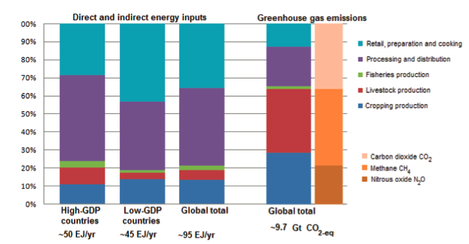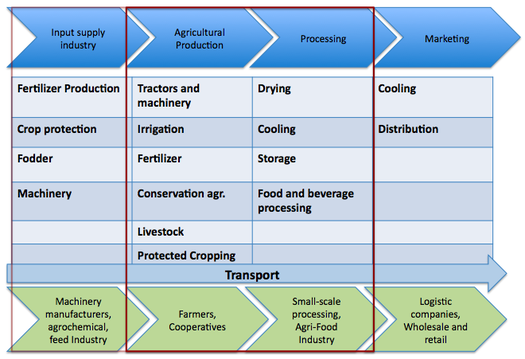Knowledge fuels change
For over a decade, Energypedia has shared free, reliable energy expertise with the world.
We’re now facing a serious funding gap.
Help keep this platform alive — your donation, big or small, truly matters!
Thank you for your support
Difference between revisions of "Energy within Food and Agricultural Value Chains"
***** (***** | *****) |
***** (***** | *****) |
||
| Line 8: | Line 8: | ||
'''''[[File:Energy consumption for high- and low-GDP countries.png|center|469px|alt=Energy consumption for high- and low-GDP countries.png]]''''' | '''''[[File:Energy consumption for high- and low-GDP countries.png|center|469px|alt=Energy consumption for high- and low-GDP countries.png]]''''' | ||
<p style="text-align: center;">''Source: FAO, 2011<ref name="FAO, 2011">FAO, 2011: “Energy-smart” food for people and climate – Issue Paper: http://www.fao.org/docrep/014/i2454e/i2454e00.pdf</ref>''</p> | <p style="text-align: center;">''Source: FAO, 2011<ref name="FAO, 2011">FAO, 2011: “Energy-smart” food for people and climate – Issue Paper: http://www.fao.org/docrep/014/i2454e/i2454e00.pdf</ref>''</p> | ||
| + | |||
= Energy Consumption within Different Steps of the Value Chain = | = Energy Consumption within Different Steps of the Value Chain = | ||
| − | + | All segments of food production are energy intensive and are heavily dependent on the use of fossil fuels. The two most energy intensive activities are found within agricultural production and processing. | |
[[File:Energy within Agricultural Value Chains.png|center|525px|alt=Energy within Agricultural Value Chains.png]] | [[File:Energy within Agricultural Value Chains.png|center|525px|alt=Energy within Agricultural Value Chains.png]] | ||
| − | <p style="text-align: center;">''Source: Author< | + | <p style="text-align: center;">''Source: Author''<br/></p> |
| − | + | == Agricultural Production == | |
| − | + | In agricultural production for example, this includes indirect energy inputs in the form of energy-intensive manufactured fertilizers and pesticides, as well as direct inputs such as diesel for tractors and tillage or energy for operating irrigation systems. | |
| − | + | Broadly, agricultural production can be divided into [https://energypedia.info/wiki/Energy_for_Agriculture#Land_Preparation.2C_Cultivation.2C_Harvesting_and_Threshing Land Preparation, Cultivation, Harvesting and Threshing] and [https://energypedia.info/wiki/Energy_for_Agriculture#Irrigation Irrigation].<br/> | |
| − | + | == Processing == | |
| − | + | Especially in emerging countries, the rapidly growing agro-industry faces the challenge to covers its energy needs within processing. In India for example, the installed capacity of the fruit and vegetable processing industry has been doubled between 1993 and 2006. Energy consumption of the Indian food processing industry (including the production of meat, fish, fruit, vegetables and oil, beverages, products by grain mills and dairies, and other foods such as bakery products, convenience products, cocoa products or salty snacks) requires 5,300 kilotons of oil equivalent per year. | |
| − | + | Most energy is consumed by processes of washing and cleaning, cooking, cooling, extraction, pureeing, brewing, baking, pasteurizing, boiling, [https://energypedia.info/wiki/Energy_for_Agriculture#Drying_of_Produce drying] and dehydration. With regards to meat, fish, fruit, vegetables and edible oil, electrical energy accounts for about 50% of energy consumption, especially for preservation and processing. In further segments such as beverages and other foods a high proportion of the required energy is needed for heating processes – which to a large extent is delivered by petroleum and biomass<ref>GIZ, 2011. Identification of Industrial Sectors Promising for Commercialisation of Solar Energy – Commercialisation of Solar Energy in Urban and Industrial Areas – ComSolar</ref>. | |
| − | + | Broadly, the most energy intensive activities are [https://energypedia.info/wiki/Energy_for_Agriculture#Drying_of_Produce drying], cooling, [https://energypedia.info/wiki/Energy_for_Agriculture#Post-harvest_and_Storage postharvest and storage], food and beverage processing. Especially in developing countries demand for cooling is increasing rapidly, where [https://energypedia.info/wiki/Solar_Cooling solar assisted cooling]is an option. | |
Revision as of 13:24, 15 July 2014
Overview
About 30% of global energy is consumed by the agricultural and food sector. Energy is needed at every level of the food value chain, including the production of agricultural inputs, agricultural production in the field, food processing, transportation, marketing and consumption. Primary agricultural consumes only about 20%, whilst food processing including transport uses around 40% and thereby significantly contributes to global energy consumption along agricultural value chains[1].
The greenhouse gas emissions of the sector are estimated by the FAO to be 9.7 Gigatons worldwide, of which nearly two thirds are caused by primary production [2]. Accurate comparative data are scarce since energy consumption and emission analysis investigate the food sector only seldom. For example, conventional statistics are hardly able to determine what proportion of energy consumption or greenhouse gas emissions of the transport sector or industry can be attributed to the food sector (cf. Intergovernmental Panel on Climate Change)[3].
Source: FAO, 2011[1]
Energy Consumption within Different Steps of the Value Chain
All segments of food production are energy intensive and are heavily dependent on the use of fossil fuels. The two most energy intensive activities are found within agricultural production and processing.
Source: Author
Agricultural Production
In agricultural production for example, this includes indirect energy inputs in the form of energy-intensive manufactured fertilizers and pesticides, as well as direct inputs such as diesel for tractors and tillage or energy for operating irrigation systems.
Broadly, agricultural production can be divided into Land Preparation, Cultivation, Harvesting and Threshing and Irrigation.
Processing
Especially in emerging countries, the rapidly growing agro-industry faces the challenge to covers its energy needs within processing. In India for example, the installed capacity of the fruit and vegetable processing industry has been doubled between 1993 and 2006. Energy consumption of the Indian food processing industry (including the production of meat, fish, fruit, vegetables and oil, beverages, products by grain mills and dairies, and other foods such as bakery products, convenience products, cocoa products or salty snacks) requires 5,300 kilotons of oil equivalent per year.
Most energy is consumed by processes of washing and cleaning, cooking, cooling, extraction, pureeing, brewing, baking, pasteurizing, boiling, drying and dehydration. With regards to meat, fish, fruit, vegetables and edible oil, electrical energy accounts for about 50% of energy consumption, especially for preservation and processing. In further segments such as beverages and other foods a high proportion of the required energy is needed for heating processes – which to a large extent is delivered by petroleum and biomass[4].
Broadly, the most energy intensive activities are drying, cooling, postharvest and storage, food and beverage processing. Especially in developing countries demand for cooling is increasing rapidly, where solar assisted coolingis an option.
Challenges to Increase Agricultural Productivity
Due to increasing scarcity of fossil energy sources as well as ailing or lacking energy infrastructure, and correspondingly rising energy prices, it is difficult to increase productivity of the agriculture and food industry in developing and emerging countries. This problem is of global economic and climate political significance, especially in the rapidly developing emerging economies whose agricultural industry has become more and more important due to high growth rates and increasing exports. Lacking access to reliable and clean energy supply increasingly turns into a significant obstacle to development – regarding the production of agricultural commodities, but especially regarding the processing of agricultural products, where there is often no alternative to inefficient and expensive diesel-powered technologies or unsustainable wood combustion. Due to the increasing demand for agricultural products in the developing and emerging countries, the adequate supply of food at reasonable prices for a growing world population cannot be guaranteed. This has significant implications for the poor who depend on the additional purchase of food.
Furthermore, the lack of energy efficiency in the agricultural and food sector causes significant greenhouse gas emissions. Hence, the greenhouse gas emissions from combusting biomass waste and from the energy needs of irrigation and agricultural machinery are estimated at more than 1,100 million tonnes of CO2 equivalence[5]. The UN IPCC identified improved energy efficiency in the agricultural sector as a key intervention in this sector[2].
Knowledge Gap
The so-called Nexus on energy and agriculture has often been ignored in the past or only been analyzed partially. Reasons include:
- Subsidy measures which often hide energy costs.
- The long period of relatively cheap supplies of fossil energy.
- The assumption that measures to increase agricultural production cannot be reconciled with the reduction of fossil energy inputs; as well as the hypothesis that energy inputs in agricultural production are either low or cannot be reduced in an economic manner.
- Lack of funding for interventions to reduce greenhouse gas emissions from the agricultural and food industry.
- Lack of focus on Nexus issues within international cooperation.
The lack of advisory and consulting services constitutes a major obstacle for the successful implementation of improvement measures in the field of sustainable energy in the agricultural and food economy. Improved financing possibilities or the technical feasibility by themselves are not sufficient, as long as they are not accompanied by technical advice, as in regards to business and operating models.
Further Information
See also Wiki article "Energy for Agriculture"
References
- ↑ 1.0 1.1 FAO, 2011: “Energy-smart” food for people and climate – Issue Paper: http://www.fao.org/docrep/014/i2454e/i2454e00.pdf
- ↑ 2.0 2.1 IPCC, 2007. Climate Change 2007: Mitigation. Contribution of Working
- ↑ Group III to the Fourth Assessment Report of the Intergovernmental Panel on Climate Change, Cambridge University Press, Cambridge, United Kingdom and New York, NY, USA
- ↑ GIZ, 2011. Identification of Industrial Sectors Promising for Commercialisation of Solar Energy – Commercialisation of Solar Energy in Urban and Industrial Areas – ComSolar
- ↑ Greenpeace, 2008. Cool Farming: Climate Impacts of Agriculture and Mitigation Potential





















